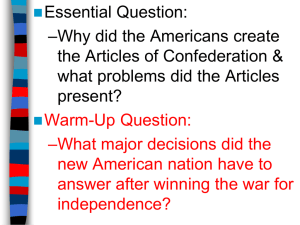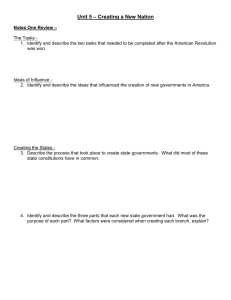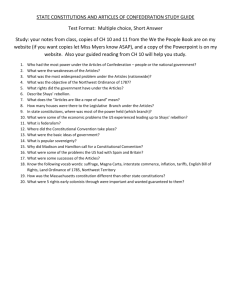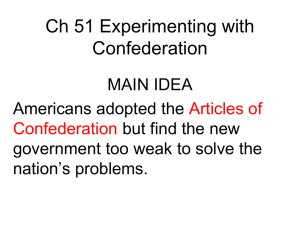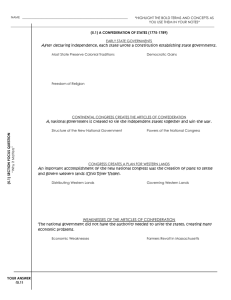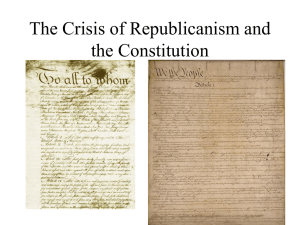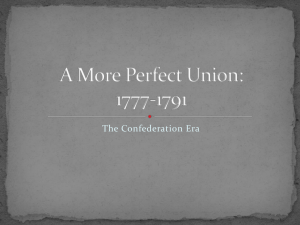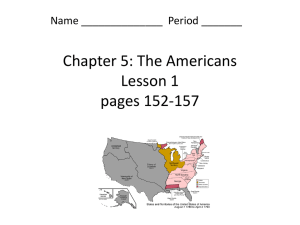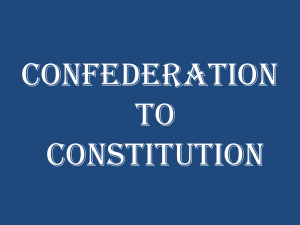CHAPTER 6 THE REPUBLICAN EXPERIMENT
advertisement
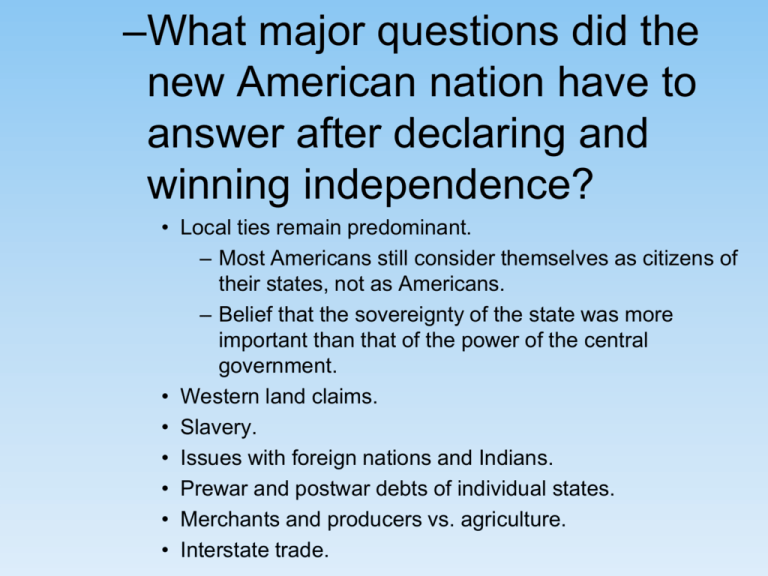
–What major questions did the new American nation have to answer after declaring and winning independence? • Local ties remain predominant. – Most Americans still consider themselves as citizens of their states, not as Americans. – Belief that the sovereignty of the state was more important than that of the power of the central government. • Western land claims. • Slavery. • Issues with foreign nations and Indians. • Prewar and postwar debts of individual states. • Merchants and producers vs. agriculture. • Interstate trade. America After Independence: “The Critical Period” Changes to American Society The American Revolution led to unintended social changes by forcing many Americans to question the meaning of “equality” – Many wanted to eliminate the idea of an American aristocracy • Eliminated primogeniture • Lowered property qualifications for voting, but none offered universal male suffrage • Most states clearly separated church and state – Fighting British tyranny made slavery seem hypocritical; Abolitionist sentiment grew • Blacks demanded the right to freedom in petitions and lawsuits • MA, VT, and PA outlawed slavery – Women gained increased status • Took greater control over family farms & businesses • “Republican Motherhood” – mothers should instill virtue in their children Postponing Full Liberty The Revolution was limited in its extension of rights & failed to abolish slavery, grant universal male suffrage, or apply equality to women; But… …it introduced the ideal of freedom and equality that future generations would use to make these ideals a reality – “Spirit of ‘76” New State & National Governments Forming New Governments When independence was declared from England in 1776, colonists considered themselves a new nation & needed a new gov’t: –Colonies became individually sovereign states governed by written state constitutions –A national gov’t was needed to provide basic services like sign treaties & develop a military States Constitutions In 1776, the new states created written constitutions which: –Clearly defined the citizens’ rights & the limits of government –Guaranteed natural rights; Eight states had bills of rights –Almost all states reduced the powers of the governor & kept most power in the hands of the people via state legislatures Defining Republican Culture a national gov’t that met everyone’s needs was hard: – How to balance individual liberty with maintaining order? – How to balance property rights with equality? – How to create a centralized gov’t without creating a new tyrannical authority? Creating Defining Republican Culture Americans set out to create a republican form of government after independence was declared: –Gov’t with no king or aristocracy –With power held by the citizens • Civic virtue now a necessity Even though all previous republics had failed, Americans were optimistic this would be an “uncompromising commitment to liberty & equality” The Articles of Confederation In 1775, three committees were formed to sever ties with England: –Thomas Jefferson headed the committee to draft a declaration of independence –John Adams headed committee to establish foreign alliances –John Dickinson headed a committee to draft a new central government Articles of Confederation The Articles of Confederation was adopted as America’s 1st national gov’t in 1777 (but ratified in 1781) – The Articles established an intentionally weak central gov’t in order to protect state power – The confederation-style gov’t gave all 13 states 1 vote in a unicameral congress • Each state treated as a pseudo-nation – There was no national president • Too monarchical The Articles of Confederation The only powers granted to the national government were to –Settle disputes between states, negotiate treaties, handle Indian affairs, oversee a military It could not tax citizens or states; could only request contributions Laws required 9 of the 13 states Amending the gov’t required agreement by all 13 states “A firm league of friendship” The colonies were loosely joined to address common problems "each State retains its sovereignty, freedom and independence, and every power...which is not... expressly delegated to the United States.…" What is the significance of the following quote: –“People do not chop off heads so readily when they can chop down trees.” The Western Lands “West” presented a problem: –Many states had overlapping land claims in the West –Some “landless” states (MD, NJ, DE) wanted part of West & refused to ratify the Articles without this issue resolved –The US gov’t negotiated treaties with Indians to gain land in Ohio, Indiana, Illinois, Kentucky The USA in the “Critical Period” The United States, 1783 Western Lands Virginia took the lead to solve the “West problem” by ceding its western claims to the national gov’t –Other states, especially NY, ceded their western lands too –By 1781, Congress (not the states) gained control over all lands west of the Appalachians With dispute over, Maryland was the last state to ratify the Articles The Land Ordinance of 1785 The U.S. gov’t was eager to sell off Western lands to settlers to gain revenue (since the gov’t did not have the power to tax) –The Land Ordinance of 1785 established an orderly process for laying out western townships –Section 16 of the each township was dedicated to public schools The Northwest Ordinance The Northwest Ordinance (1787) gave structure to the NW territory: – Created new territories, ruled by a governor, & whose citizens were protected by a bill of rights – Residents could create a legislative assembly when the population reached 5,000 – Residents could apply for statehood with 60,000 people • Not less than three nor more than 5 – Slavery outlawed in NW lands Conclusions The Articles of Confederation accomplished exactly what its framers intended: –By creating a weak central gov’t, the power of the states was preserved & no tyrants emerged –The weaknesses of the central gov’t failed to meet the longterm needs of the new USA
